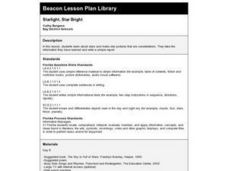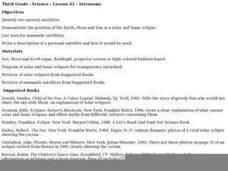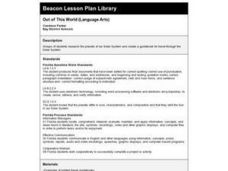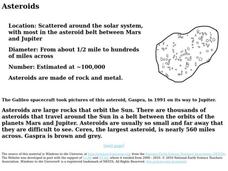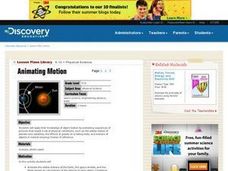Curated OER
Earth Day/Nature Vocabulary
In this nature vocabulary activity, students identify nature vocabulary words by choosing the correct word for each picture. Students complete 18 problems.
Curated OER
Starlight, Star Bright
First graders read books and use the Internet to identify several constellations and stars in the night sky. They make star pictures and write a class report about the night sky including a title, complete sentences and a cited reference.
Curated OER
English Exercises: Activities to Teach Peace
In this English exercises: activities to teach peace worksheet, 5th graders listen the the song Together, interactively select 13 words to complete the lyrics, read a quote, explain it and draw a picture about it, make a peace booklet...
Curated OER
Introduction to Geology Quiz Worksheet
In this earth science fill-in-the-blank worksheet pupils complete 8 questions about an geology. They see a picture of a rock and a volcano on the page. They check their work with the word bank at the bottom of the page.
Curated OER
Uranus Facts Research Recording Worksheet
In this Uranus research recording worksheet, students see a black line picture of the planet in the middle of the page. They fill in 5 facts about the planet which include its distance from the sun, its distance across, and the length of...
Curated OER
Moons
Students practice rote counting to 20. After a lecture about the planets and the moons that surround them, they identify the number of moons surrounding various planets. Students compare and contrast the quantity of moons surrounding...
Curated OER
Science - Lesson 42 - Astronomy
Third graders demonstrate the position of the Earth, Moon, and Sun in a solar and lunar eclipse. They list uses for manmade satellites and write a description of how a satellite would be use.
Curated OER
Out of This World (Language Arts)
Second graders, in groups, research the planets in the solar system and create a guidebook for travel.
Curated OER
How Many?
In this book-making learning exercise, students create a number and color book. Each page gives a picture of a group of items with a sentence. Students insert the correct number and trace the color word.
Curated OER
The Earth
In this earth fact worksheet, students look at a picture of the planet earth and read a list of accompanying facts, along with a brief paragraph.
Curated OER
Asteroids
In this worksheet on asteroids, students look at a picture asteroids and read accompanying facts, along with a brief paragraph.
Curated OER
Once In a Blue Moon
Students review the characteristics of the planets and their moons. Using the internet, they research the relationship between the Earth and its moons. They take a template of the moon and draw craters of different colors to present to...
Curated OER
Scale from the Solar System to a Monster Bee
Sixth graders are introduced to the concept of scale. As a class, they create a model of the solar system taking into account the scale between the planets and the Sun. To end the lesson, they examine "Dina the Monster Bee" and discover...
Curated OER
Space Trading Cards
Students use the Internet and other reference sources to gather information on a space topic. They create a trading card displaying the information learned and import pictures from libraries and the Internet.
Curated OER
Animating Motion
Students apply what they recall about objects in motion by animati ng sequences of pictures that model a set of physical conditions. They animate the orbital motions of the Earth, the space shuttle, and the Moon based on calculations of...
Curated OER
Sunspots and Climate
High schoolers make a graph that shows how the number of sunspots has changed over the past 30 years and discover how there is a pattern in sunspot number. They find a disruption in this pattern due to the Little Ice Age.
University of Washington
Kepler’s Laws
Introduce your physics or astronomy class to Kepler's laws of planetary motion with this straightforward worksheet. It covers the basic concepts of each and has learners answer questions to demonstrate their grasp on them. You could use...
Messenger Education
Exploring Solar Systems Across the Universe
Scientists have theorized that our solar system formed 4.6 billion years ago. In this pair of activities, learners first hypothesize how our solar system was formed. Using this information, groups then determine how scientists search for...
Curated OER
What Makes Jokes Funny?
Explore how language is used for comic effect. Middle schoolers determine which of the three formulas for jokes (double meanings, unexpected outcome, humorous mental image) make each of 18 classic, corny examples funny. They complete a...
Messenger Education
Dangers of Radiation Exposure
Gamma radiation, which is harmful, is useful in treating cancers. In the second lesson in a series of four, young scientists take surveys and calculate their yearly exposure to ionizing radiation. Then they read about how harmful their...
Curated OER
Exploring the Sky: Reading Maria's Comet
Discover the science behind astronomy. After reading the book Maria's Comet, which is about a young woman who breaks new ground by becoming a female astronomer, young learners practice reading comprehension with worksheet questions about...
Curated OER
Space Science: Adventure is Waiting
These full-color handouts feature two activities. The first is a reading on comets, meteors, and meteoroids. Your space science learners will examine ten phrases and determine which of the three each characterizes. The second activity...
Science Geek
Electrons in Atoms
Electrons could never be Bohring! The presentation covers where you find electrons in an atom. It begins with the Bohr Model, then moves on to the Heisenberg Principle and orbital shapes. It concludes with the concept of electron spin...
Curated OER
Zodiac Constellations
In this space science learning exercise, students learn to identify the 12 constellations of the Zodiac. Students read the information and look at the detailed drawings of each constellation and when it is visible in the night sky.



